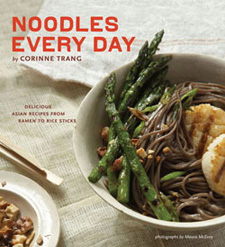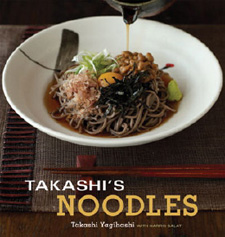 If we didn’t live in New York or LA (or Tokyo or London), we would have to make something from this cookbook at least once every two weeks, even if we did have to ship some of the ingredients in by mail order. But it’s the concept of the fusion of the East and West that he does in a way that no one else does, fascinating to read and to experiment with.
If we didn’t live in New York or LA (or Tokyo or London), we would have to make something from this cookbook at least once every two weeks, even if we did have to ship some of the ingredients in by mail order. But it’s the concept of the fusion of the East and West that he does in a way that no one else does, fascinating to read and to experiment with.
World Cuisine
World Cuisine
India: The Cookbook

India: The Cookbook
The amount most of us knows about Indian cuisine is miniscule. And yet, who doesn't love Indian food? Making it at home using the best ingredients is a revelation. This book has the largest collection of Indian recipes that I have ever seen. The introductory sections on the regions of India alone is wonderful.
Bookmarked recipes: Dry cabbage in masala, Lamb in chickpea flour and curry yogurt, Coconut filled pancakes
Why?
This encyclopedia of 1000 recipes will be your go-to Indian cooking reference.
Who?
Those who love Indian food but want to experience a wider variety of fresh, tasty food than they can find in any given Indian restaurant.
Noodles Every Day
 Noodles Every Day
Noodles Every Day features quick and easy recipes. For these recipes you will need the
basics of an Asian pantry which are explained in detail in an early
chapter. All are available at an Asian grocery store or online. However
a few recipes have some more exotic ingredients like garland
chrysanthemum leaves or silver pin noodles. All the recipes are titled
descriptively so Pad Thai becomes Stir-Fried Rice Sticks with Tamarind
Sauce, Dried Shrimp, Tofu, Sprouts, and Eggs.
Over the years I've had very good luck with author Corinne Trang's recipes and this book is no exception. Her Somen Noodles with Shrimp Curry and Peas uses less than 10 ingredients and is the perfect kind of one pot meal you'll likely be able to make with peas and shrimp in your freezer and without a trip to the store. The book is divided into sections based on the type of noodle you are using--egg, rice, buckwheat, etc. and it also has a section on buns, dumplings and spring rolls.
Takashi's Noodles
 First up is Takashi's Noodles. They say if you get just one great recipe from a cookbook, it is worth the price. In that case, let me tell you about Spicy Eggplant Ja-Ja-Men Udon. Chef Yakashi Takashi, owner of Takashi's in Chicago describes
this dish as a Japanese version of spaghetti and bolognese sauce. It's
basically a spicy eggplant and ground pork sauce over noodles with
peppers, spicy notes and a creamy sauce that is enriched with sesame
paste.
First up is Takashi's Noodles. They say if you get just one great recipe from a cookbook, it is worth the price. In that case, let me tell you about Spicy Eggplant Ja-Ja-Men Udon. Chef Yakashi Takashi, owner of Takashi's in Chicago describes
this dish as a Japanese version of spaghetti and bolognese sauce. It's
basically a spicy eggplant and ground pork sauce over noodles with
peppers, spicy notes and a creamy sauce that is enriched with sesame
paste.
The recipe has 18 ingredients but I skipped a few altogether and used substitutions for a couple more and can't imagine it made any discernible difference. I didn't bother with the 1/2 cup dashi, 1/3 cup canned bamboo shoots, teaspoon of cornstarch or 3 Tablespoons of sake. I used Chinese chili garlic paste instead of a Japanese variety and Chinese sesame paste instead of tahini. I had to buy exactly 2 ingredients to make the dish, green peppers and ground pork. I could eat this dish every week.!
Fundido Three Ways
 Just in time for Cinco de Mayo, these recipes - one each for the meat lover, seafood lover and vegetarian - were created by Chef Eduardo Garcia, co-founder of Montana Mex seasoning salts, which are used in each recipe (and available online). What's better than melted cheese mixed with mexican spices?
Just in time for Cinco de Mayo, these recipes - one each for the meat lover, seafood lover and vegetarian - were created by Chef Eduardo Garcia, co-founder of Montana Mex seasoning salts, which are used in each recipe (and available online). What's better than melted cheese mixed with mexican spices?
Lamb And Mint Fundido
Serves 4
Ingredients:
1 lb of ground lamb
6 Tablespoons of chopped fresh mint
2 Tablespoons minced fresh garlic
6 Tablespoons of chopped fresh thyme, woody stems removed
3 teaspoons Montana Mex Picante Salt
4 oz Oaxaca Cheese, grated
2 tablespoons Olive Oil
Method:
Pre-heat oven on Low Broil
1. Large saute pan, on medium heat, add olive oil and lamb, saute and break as you would ground beef for tacos, about 4 minutes.
2. Add thyme, garlic, Montana Mex picante salt and saute until garlic is cooked, about 2 minutes.
3. Turn off heat, add all the mint and stir to combine well.
4. In a shallow oven-proof dish/casserole dish, spread meat mixture evenly on the bottom, and cover with all the grated Oaxaca Cheese.
5. Broil on Low in the oven until cheese is melted and golden brown, about 2 minutes.
Serve warm with warm corn tortillas/favorite tortilla chips.
More Articles ...
Welcome to the new One for the Table ...
Our Home Page will be different each time you arrive.
We're sure you'll find something to pique your interest...


